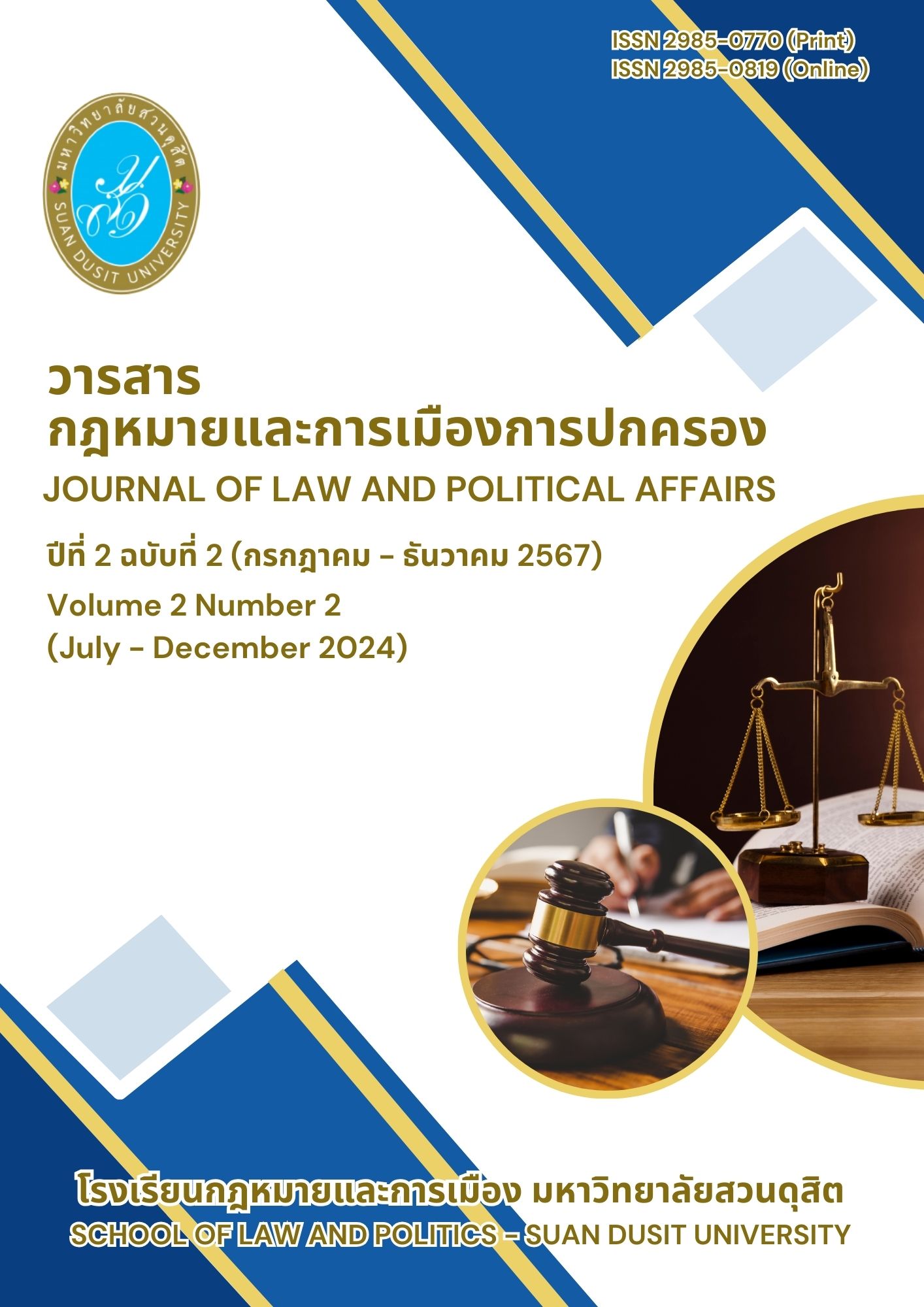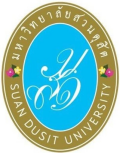Management of strong sub-districts cooperative through participatory communication
Keywords:
Management of strong sub-districts, strong sub-districts cooperative, participatory communicationAbstract
A sub-district is an area that is diverse in terms of physical dimensions, way of life, culture, and others. It has four organizational components called Chatupalang, which means that the sub-district is managed under 4 main mechanisms, namely the regional administrative mechanism, local government administration mechanisms, civil society mechanisms and cooperation mechanisms from other agencies, which can be assembled into Sub-district self-management system in the form of governance by partnerships and joining synergy to integrate work into a strong sub-district system to achieve sustainable development goals. The objective of this academic article is to point out the importance of managing strong subdistricts in partnership with participatory communication and to develop proposals for the development of strong subdistricts using participatory communication as an important tool. To support national development according to the national strategy and national reform plan that emphasizes integrated and sustainable development. Participatory communication places importance on the reactions of the receivers from the process of joint thinking, joint decision making, joint action, and joint benefits. It is also an important mechanism for promoting the development of sustainable community through communication between the project working group and project members, communication between working groups and between members.
References
กมลศักดิ์ วงศ์ศรีแก้วและคณะ. (2560). การพัฒนาชุมชนเข้มแข็ง: กรณีศึกษาชุมชนพูนบำเพ็ญ เขตภาษีเจริญ กรุงเทพมหานคร. วารสารพัฒนาชุมชนและคุณภาพชีวิต, 5(1), 46-57.
กาญจนา แก้วเทพ. (2543). สื่อสารมวลชน ทฤษฎีและแนวทางการศึกษา. กรุงเทพฯ: เอดิสัน เพรส โพรดักส์.
โกวิทย์ พวงงาม. (2553). การจัดการตนเองของชุมชนแบะท้องถิ่น. กรุงเทพฯ: บพิธการพิมพ์.
คณะกรรมาธิการการแก้ปัญหาความยากจนและลดความเหลื่อมล้ำ วุฒิสภา. (2564). รายงานคณะกรรมาธิการการแก้ปัญหาความยากจนและลดความเหลื่อมล้ำ วุฒิสภา เรื่อง การจัดการตำบลเข้มแข็งตามแนวทางยุทธศาสตร์ชาติและแผนการปฏิรูปประเทศ. กรุงเทพฯ: สำนักการพิมพ์สำนักงานเลขาธิการวุฒิสภา.
จามะรี เชียงทอง. (2549). สังคมวิทยาพัฒนาการ. กรุงเทพฯ: โอเดียนสโตร์.
นภาภรณ์ หะวานนท์และคณะ. (2550). ทฤษฎีฐานรากในเรื่องความเข้มแข็งของชุมชน. กรุงเทพฯ: สำนักงานกองทุนสนับสนุนการวิจัย.
ประเวศ วะสี. (2551). สร้างเจดีญเริ่มจากฐาน สร้างสังคมเริ่มจากชุมชน. กรุงเทพฯ: สำนักงานกองทุนสนับสนุนการสร้างเสริมสุขภาพ.
__________. (2551). จุดเปลี่ยนประเทศไทย หัวใจคือชุมชน. กรุงเทพฯ: กรีน ปัญญาญาณ.
ปัณณพงศ์ วงศ์ณาศรี. (2561). วิเคราะห์บริบทความท้าทายขององค์กรปกครองส่วนท้องถิ่นในการบริหารท้องถิ่นเพื่อขับเคลื่อนนวัตกรรมท้องถิ่นในยุคไทยแลนด์ 4.0. วารสารอาศรมวัฒนธรรมวลัยลักษณ์, 20(1). 63-78.
ปาริชาต สถาปิตานนท์. (2551). การสื่อสารประเด็นสาธารณะและการเปลี่ยนแปลงในสังคมไทย. กรุงเทพ: จุฬาลงกรณ์มหาวิทยาลัย.
พระมหาจรูญ กิตฺติปญฺโญ และจรัส ลีกา (2564). การสร้างความเข้มแข็งแก่ชุมชนในยุคไทยแลนด์ 4.0 กรณีศึกษาชุมชนเข้มแข็งองค์การบริหารส่วนตำบลหนองกุงธนสาร อำเภอภูเวียง จังหวัดขอนแก่น. วารสารบัณฑิตศึกษามหาจุฬาขอนแก่น, 8(1), 189-201.
ภัทร์ฐิตา ทุมเกิด. (2565). ตำบลต้นแบบนวัตกรรมชุมชนเข้มแข็งสร้างเศรษฐกิจไทยแข็งแรง. บทความหนังสือพิมพ์บ้านเมืองออนไลน์. สืบค้นเมื่อ 5 สิงหาคม 2566. https://www.banmuang.co.th/column/politic/6862
วสันต์ ลิ่มรัตนภัทรกุลและ ธัชชนันท์ อิศรเดช. (๒๕๖๓). รายงานวิจัยชุมชนเรื่อง “ชุมชนท้องถิ่นกับการจัดการปัญหาความเหลื่อมล้ำเพื่อการพัฒนาอย่างยั่งยืน”. กรุงเทพฯ: สถาบันพระปกเกล้า.
สถาบันพัฒนาองค์กรชุมชน (องค์การมหาชน). (2562). รวมบทเรียน นวัตกรรมชุมชนท้องถิ่น จัดการตนเองและพื้นที่ปฏิบัติการเรียนรู้ใหม่ พัฒนาคน พัฒนาชุมชนท้องถิ่นเข้มแข็ง. กรุงเทพฯ: สถาบันพัฒนาองค์กรชุมชน (องค์การมหาชน)
_________. (2564). โมเดลนวัตกรรมชุมชนเข้มแข็ง 50 บทเรียนการพัฒนาตำบลต้นแบบนวัตกรรมชุมชนเข้มแข็ง. กรุงเทพฯ: สำนักพัฒนานวัตกรรมชุมชนจัดการความรู้และสื่อสาร สถาบันพัฒนาองค์กรชุมชน (องค์การมหาชน).
_________. (2564). รายงานประจำปี 2564. กรุงเทพฯ: สถาบันพัฒนาองค์กรชุมชน (องค์การมหาชน).
สมบูรณ์ ธรรมลังกา. (2556). รูปแบบการเสริมสร้างความเข้มแข็งของชุมชนโดยใช้ภูมิปัญญาท้องถิ่นเป็นฐานในจังหวัดเชียงราย. วารสารศึกษาศาสตร์ มหาวิทยาลัยนเรศวร, 15(2), 58-66
สำนักงานคณะกรรมการพัฒนาระบบราชการ. (2565). การประชุมคณะทำงานจัดทำคู่มือแนวทางการบริหารจัดการตำบลเข้มแข็งแบบหุ้นส่วน. สืบค้นเมื่อ 20 เมษายน 2565. https://www.opdc.go.th/content/ODEwNA
สำนักงานสภาพัฒนาการเศรษฐกิจและสังคมแห่งชาติ. (2563). รายงานสรุปผลการดำเนินการตามแผนการปฏิรูปประเทศ ประจำปี 2562. กรุงเทพฯ: ซีดี มีเดีย ไกด์
อินทร วิชิตตานนท์ และเตชพล ฐิตยารักษ์. (2547). ชุมชนเข้มแข็ง: หนทางสู่การพัฒนาที่ยั่งยืน. วารสารเศรษฐกิจและสังคม.,41(1), 11-16.
Brown, J. and Isaacs, D. (1994). The Department of Sustainability and Environment as cited in Ismael Ahmed Awad, et al. (2019) Community participation role in interior urbanism to consolidate neighbors’ social values in residential communities. International Design Journal, 9(1), 191-198.
Cohen, J. and Uphoff, N., (1977). Rural Development Participation: Concepts and Measures for Project Design, Implementation and Evaluation. New York: Cornell University.
Fornaroff, A. (1980). Community involvement in Health System for Primary Health Care. Geneva: World Health Organization.
Jacobson, T. & Kolluri, S. (1999). Participatory Communication as Communication Action, Theoretical approaches to participatory communication. Cresskill. New York: Hampton Press.
Servaes, J., et al., (1996). Participatory communication for social change. California: Sage.
Downloads
Published
How to Cite
Issue
Section
License
Copyright (c) 2024 Journal of Law and Political Affairs

This work is licensed under a Creative Commons Attribution-NonCommercial-NoDerivatives 4.0 International License.
ลิขสิทธิ์ต้นฉบับที่ได้รับการตีพิมพ์ในวารสารกฎหมายและการเมืองการปกครอง มหาวิทยาลัยสวนดุสิต ห้ามผู้ใดนำข้อความทั้งหมดหรือบางส่วนไปพิมพ์ซ้ำ เว้นแต่จะได้รับอนุญาตอย่างเป็นลายลักษณ์อักษรจากโรงเรียนกฎหมายและการเมือง มหาวิทยาลัยสวนดุสิต นอกจากนี้ เนื้อหาที่ปรากฎในบทความเป็นความรับผิดชอบของผู้เขียน ทั้งนี้ไม่รวมความผิดพลาดอันเกิดจากเทคนิคการพิมพ์







